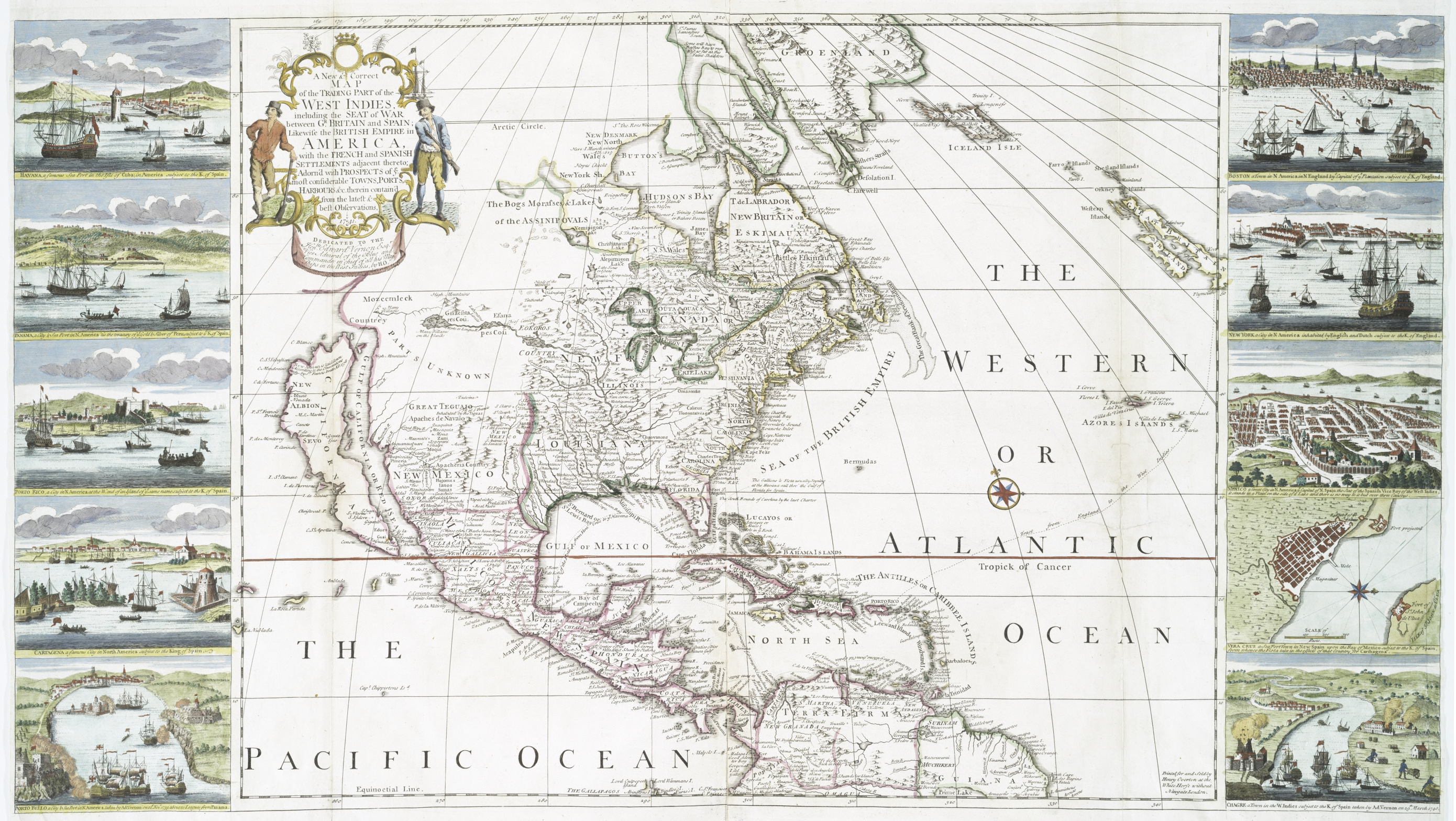
BRITISH CAMP ON CUBA,
1741
The British invasion of Cuba was a failure for reasons that this map of
the well-defended position they established in Guantanamo Bay did not reveal.
An attack on the major port of Santiago was planned, but the British troops
were landed in the bay more than eighty miles away. This foolishly exposed them
to a long and dangerous advance through woody terrain ideal for Spanish
guerrilla action. The troops suffered heavily from disease, did not reach their
goal and were re-embarked. Santiago was to fall to American attack in 1898. An
earlier British attack on Cartagena (in modern Colombia) and a later one on
Panama, both in 1741, also failed.
The bay was called Guantánamo by its original inhabitants, the Taínos.
Christopher Columbus landed in 1494, naming it Puerto Grande. On landing,
Columbus’ crew found Taíno fishermen preparing a feast for the local chieftain.
When Spanish settlers took control of Cuba, the bay became a vital harbor on
the south side of the island.
The bay was briefly known as Cumberland Bay when the British seized it
in 1741, during the War of Jenkins’ Ear. British Adm. Edward Vernon arrived
with a force of eight warships and 4,000 soldiers with plans to march on
Santiago de Cuba. However, he was defeated by local guerrilla forces of creole
and Spaniards and forced to withdraw or face becoming a prisoner. In late 1760,
boats from HMS Trent and HMS Boreas cut out the French privateers Vainquer and
Mackau, which were hiding in the bay. The French were also forced to burn the
Guespe, another privateer, to prevent her capture.
WAR OF JENKINS’ EAR (1739–1742)
The War of Jenkins’ Ear, an armed conflict between Britain
and Spain, arose from longstanding Anglo-Spanish antagonism fostered by illicit
British trading activities in the Spanish Caribbean and the determined, often brutal,
attempts by Spain’s colonial guarda costa (‘coast guard’) vessels to suppress
such ventures. Popular feeling, incited by opponents of the Walpole ministry in
London and a vigorous merchant lobby opposed to diplomatic efforts, further
intensified pressures conducive to war.
The immediate events that precipitated open hostilities were the alleged
sinking of several British merchant ships by Spanish privateers, the suspension
of the asiento or slave supply contract, and the intensification of Spain’s search
and seizure claims against British smuggling vessels, and, marginally, the ill
usage suffered by one Capt. Robert Jenkins, Master of the brig Rebecca.
Legitimately bound for London from Jamaica with a cargo of sugar, Jenkins’s
ship was plundered and his ear severed by the commander of a Spanish coast
guard vessel near Havana on 9 April 1731.
The case received brief publicity, subsided, but then was
revived (together with other, similar incidents) during a stormy Commons debate
in March 1738. Although modern research has established that, contrary to
historical tradition, Jenkins never appeared personally to present the missing
ear; his plight was highly dramatized and contributed to the momentum of the
political opposition campaign urging an immediate offensive against Spain. This
appealed to national sentiment and commercial interests alike. Temporizing,
Walpole arranged the Convention of Pardo with Spain, which provided
compensation for vessels, lost but avoided the crucial issue: Spain’s continued
determination to suppress all smuggling attempts. Confronted with growing
public and parliamentary indignation, Walpole finally had to yield and war was
declared on 19 October 1739.
In the lacklustre naval operations that followed, Admiral
Vernon (1684–1757) sacked Porto Bello (in modern Panama) in November 1739, but
the attack on Cartagena (Colombia) in early March 1741 failed due to spirited
Spanish resistance, tropical disease, and dissension between British army and
navy commanders. Commodore George Anson, operating with a small squadron off
Chile, marauded coastal areas, and then circumnavigated the globe in the HMS
Centurion (1740–1744), capturing Spanish treasure along the way. Attempts to
seize Cuba in December 1741 and raids along the Florida coast were largely
fruitless, resulting in heavy British casualties. Gradually the war overseas
petered out into desultory forays against Spanish shipping and ineffectual
attempts to isolate Spain from her colonies before becoming enveloped and
overshadowed by hostilities in Europe (War of the Austrian Succession,
1740–1748) in which Britain, by means of mercenary forces, supported Austria
against France (who had joined Spain) and her German allies.
While in its altered, Continental dimension the war enabled
Britain to contain threatening Bourbon expansionism in key strategic areas
abroad during the period 1742–1748, overseas it failed to achieve the initially
anticipated sweeping victory over Spain.
Small-scale Anglo-Spanish clashes in Caribbean and Mediterranean waters
produced little monetary or strategic gain, clearly indicating that naval
action was not the solution to Britain’s commercial grievances at this time,
nor the key to much-needed political stability.
Santiago in Cuba
The failed British naval invasion of Cartagena, a Spanish
port city in modern-day Colombia, during March 22-May 9, 1741. During the
Anglo-Spanish War (1739-1744), Britain, with the assistance of thousands of
soldiers from its North American colonies, staged a disastrous amphibious
assault against Cartagena.
Attacks in the spring and summer of 1741 on Cartagena in
modern-day Colombia and Santiago in Cuba were humiliatingly repulsed. Disease
made terrible inroads into the army and navy, and arguments between the naval
and military commanders made effective cooperation impossible.
The British had completely abandoned Cartagena by May 9 and
returned to Jamaica. Disease continued to devastate Wentworth’s troops to the
point that he had only about 3,000 soldiers left. The expedition against the
Spanish in the West Indies continued to fizzle. After returning to Jamaica the
troops prepared for an assault on Santiago de Cuba but became bogged down near
Guantanamo Bay, where the force fought only disease. By the time the orders to
return home finally arrived, more than 10,000 men had perished, only 1,000 of
them in action. American colonists perceived the deaths as evidence of the
British Empire’s callousness, which helped fuel the development of a separate
colonial identity.